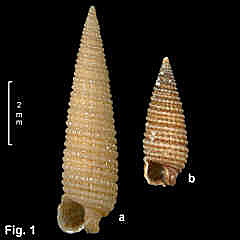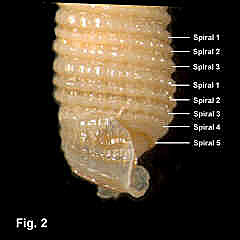|
|
TRIPHORIDAE |
|
|
|
Monophorus angasi (Crosse & P. Fischer, 1865) Description: Shell relatively small, sinistral. Protoconch plankotrophic, of 3½-4½ whorls, with 2 spiral threads and numerous axial riblets. Teleoconch whorls with 4 beaded spiral cords and numerous axial costae; spirals 1 and 3 commence immediately after protoconch, spiral 2 developing on 4th or 5th teleoconch whorl; spiral 4 only exposed on last whorl. Further 1 or 2 spirals on base (numbered 5 and 6). Axial costae of similar strength to spirals, nodulose at intersections, 19-24 on penultimate whorl. Outer lip of aperture flared, anterior siphonal canal short, slightly upturned, posterior canal a broad triangular notch. Colour yellowish or reddish brown, darker on base, tops of nodules sometimes lighter, sutural zone and interspaces between spirals sometimes dark brown (form fulvalinearis). Size: Adult shells 3.3 - 8.2 mm in length. Distribution: Endemic to Australia: Port Stephens, NSW, southwards and around southern Australia, including Tasmania, to south-western WA. Habitat: Living specimens are known from the intertidal zone on rocky shores. Empty shells are know from beach washup down to about 150 m. Common. Synonymy: Notosinister fulvalinearis Laseron, 1954 (Fig. 1b) was based on a specimen with the sutural zone and interspaces between spirals dark brown. Remarks: One of the most common triphorid species in NSW. Fig. 1: a. Twofold Bay, NSW (C.065956) b. Holotype of Notosinister fulvalinearis Laseron, 1954. Little Coogee Bay, NSW (C.065858) Fig. 2: Detail of aperture of specimen in Fig. 1a |
|

